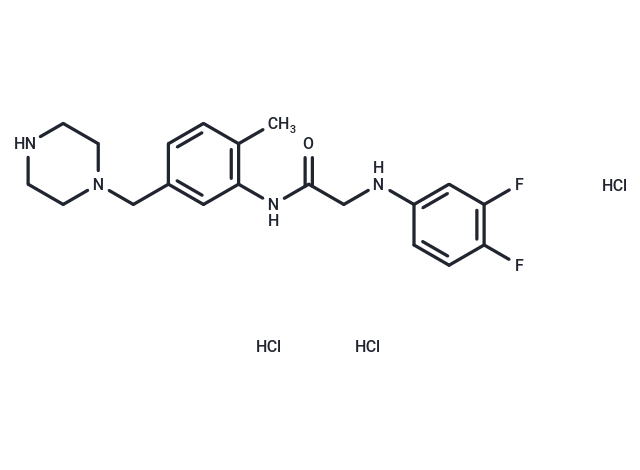Shopping Cart
- Remove All
 Your shopping cart is currently empty
Your shopping cart is currently empty

GW791343 trihydrochloride (GW791343 3HCl) is aHCl salt form of GW791343, which is a non-competitive allosteric modulator of human P2X7 receptor inhibitor with pIC50 of 7.

| Pack Size | Price | Availability | Quantity |
|---|---|---|---|
| 5 mg | $72 | 1-2 weeks | |
| 10 mg | $123 | 1-2 weeks | |
| 25 mg | $221 | 1-2 weeks | |
| 100 mg | $853 | 1-2 weeks | |
| 1 mL x 10 mM (in DMSO) | $87 | 1-2 weeks |
| Description | GW791343 trihydrochloride (GW791343 3HCl) is aHCl salt form of GW791343, which is a non-competitive allosteric modulator of human P2X7 receptor inhibitor with pIC50 of 7. |
| Targets&IC50 | P2X7:7(pIC50) |
| In vitro | Synephrine (0.1-30 μM) displays potent vasoconstrictive effects on isolated rat aorta in a dose dependent manner, which can be significantly inhibited by pretreatment with prazosin, BRL15572, and ketanserin but not by pretreatment with SB216641 and propranolol, indicating that Synephrine exerts the constrictive effects via adrenergic alpha(1)-receptors, serotonergic 5-HT(1D) receptors, and 5-HT(2A) receptors. [2] Although the Ki values of Synephrine, 1R,2S-norephedrine, and β-phenethylamine are same for all three subtypes, only Synephrine is a partial agonist of α1A-AR subtype stably expressed in HEK 293 cells with EC50 of 4 μM, giving a maximal response at 100 μM that is equal to 55.3 % of the L-phenylephrine maximum. Functional studies on the α2A- and α2C-AR subtypes stably expressed in CHO cells indicate that Synephrine may act as an antagonist rather than an agonist of the pre-synaptic α(2A)- and α(2C)-AR subtypes present in nerve terminals, although antagonist activity of synephrine is lower than its partial agonist potency. [3] Synephrine (~100 μM) treatment increases basal glucose consumption up to 50% over the control in a dose-dependent manner, without affecting the viability of L6 skeletal muscle cells. Synephrine significantly stimulates the basal- or insulin-stimulated lactic acid production as well as glucose consumption. Synephrine treatment stimulates the phosphorylation of AMPK but not Akt, and Synephrine-induced glucose consumption and the translocation of Glut4 from the cytoplasm to the plasma membrane are sensitive to the inhibition of AMPK but not to the inhibition of PI3 kinase. [4] |
| Alias | GW791343 3HCl |
| Molecular Weight | 483.81 |
| Formula | C20H24F2N4O·3HCl |
| Cas No. | 309712-55-8 |
| Relative Density. | no data available |
| Storage | Powder: -20°C for 3 years | In solvent: -80°C for 1 year | Shipping with blue ice. | |||||||||||||||||||||||||||||||||||
| Solubility Information | DMSO: 48.4 mg/mL (100.04 mM), Sonication is recommended. | |||||||||||||||||||||||||||||||||||
Solution Preparation Table | ||||||||||||||||||||||||||||||||||||
DMSO
| ||||||||||||||||||||||||||||||||||||

Copyright © 2015-2025 TargetMol Chemicals Inc. All Rights Reserved.